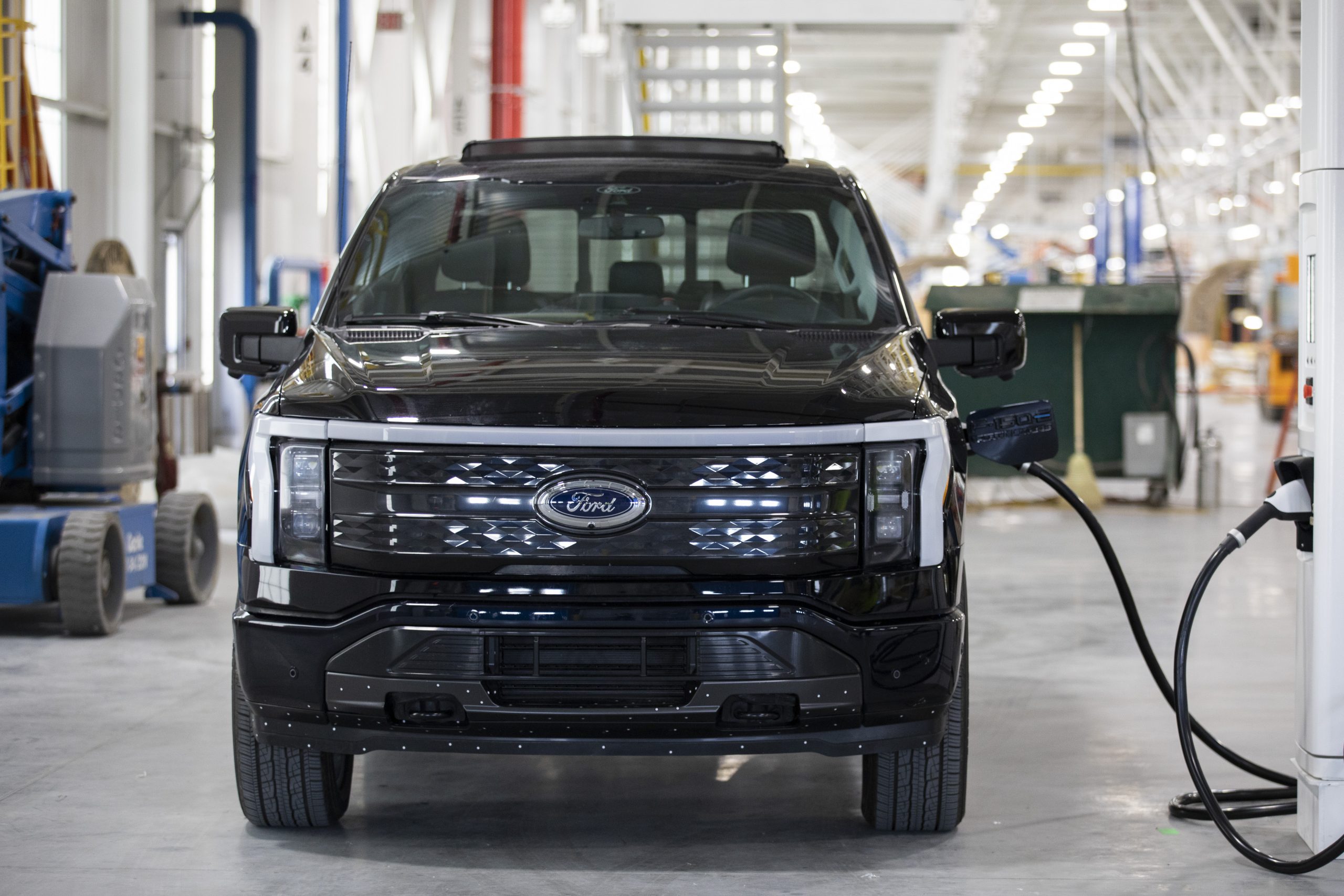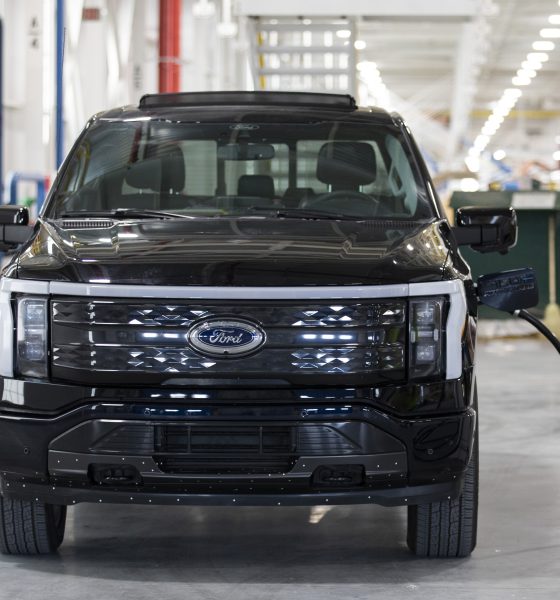

News
Ford says it is stockpiling batteries for Farley’s electric vehicle scaling operation
Ford said it is stockpiling batteries to achieve CEO Jim Farley’s recently outlined goals of scaling production of 600,000 electric vehicles produced in just 22 months; a lofty goal for the Detroit-based automaker, which held its Q4 2021 Earnings Call last evening.
In late January, Farley stated that he believed Ford could be one of the first legacy automakers to scale electric vehicle production by suggesting the company could manufacture 600,000 units in 22 months. Ford, which has set aside massive budgets for electrification efforts, raised production targets on the Mustang Mach-E and F-150 Lightning, which has not entered production yet.
Farley bumped Mustang Mach-E production to 200,000 units per year by 2023. F-150 Lightning production was slated for 40,000 annual units at its unveiling event last Spring. This has been essentially quadrupled to 150,000 units per year, bringing Ford’s production targets to unprecedented levels. A bold move for a company with a long and storied history of combustion engines. In the world of EVs, Ford is relatively a newcomer, but it has not stopped the company from performing exceptionally in the U.S. market, falling second to only Tesla in sales figures for Q4 2021.
During last evenings Q4 Earnings Call, Farley gave additional details on the scalability project, indicating that the company’s biggest bottleneck is cell availability:
“Really, the primary lift for us is battery availability. So we’ve actually been securing extra batteries for quite some time now. We have some manning options for Mach-E. So we will move close to 100,000 units this year on Mach-E. That will be our big move this year. Next year, our big move will be Lightning going to 150,000 units. I won’t get into battery chemistries and all the details, but I’m really excited about the progress we’ve made so far in securing batteries. On the F-150 Lightning, we actually had a physical capacity constraint of the facility. And so, we took the decision already to again redesign the facility so that we can accommodate the 150,000 units. We have great capacity on F-150 for the nonelectric components. So this is just a matter of the Mach-E getting the labor in place and getting the batteries and the F-150 getting the batteries out of Georgia and redesigning the facility so we can get the final assembly done. As far as chips are concerned, these battery electric vehicles and the supply chain are a strategic advantage for our company.”
It seems Farley is overwhelmingly confident that the production lines and manufacturing capabilities of Ford throughout its series of facilities can handle the increases in production. However, the only real way Ford would end up falling short is by not having enough cells to place in its battery packs.
One year after Ford confirmed construction of the Rouge Electric Vehicle Center in Dearborn, Mich., the first Ford F-150 Lightning pre-production units begin leaving the factory. Pre-production model shown. (Credit: Ford)
Ford has been essentially stockpiling these cells to keep bottlenecks at bay. The strategy essentially worked for Tesla when it was accumulating chips preparing for the semiconductor shortage. A supplier executive for Tesla detailed “buffer stock” as a strategy that the automaker used to avoid potential supply limitations. Ford seems to be involving the same strategy to avoid cell bottlenecks.
Ford recently restructured its EV playbook with a $20 billion budget and new talent, including Doug Field, a former Tesla and Apple engineer.
I’d love to hear from you! If you have any comments, concerns, or questions, please email me at joey@teslarati.com. You can also reach me on Twitter @KlenderJoey, or if you have news tips, you can email us at tips@teslarati.com.
Quotes provided by The Motley Fool.

News
Tesla Semi program Director teases major improvements

Tesla Semi Program Director Dan Priestly teased the major improvements to the all-electric Class 8 truck on Thursday night, following the company’s decision to overhaul the design earlier this year.
Priestley said he drove the Semi on Thursday, and the improvements appear to be welcomed by one of the minds behind the project. “Our customers are going to love it,” he concluded.
Just drove the redesigned Semi. Our customers are going to love it. https://t.co/KZ88sf1CDL
— Dan Priestley (@danWpriestley) December 19, 2025
The small detail does not seem like much, but it is coming from someone who has been involved in the development of the truck from A to Z. Priestley has been involved in the Semi program since November 2015 and has slowly worked his way through the ranks, and currently stands as the Director of the program.
Tesla Semi undergoes major redesign as dedicated factory preps for deliveries
Tesla made some major changes to the Semi design as it announced at the 2025 Annual Shareholder Meeting that it changed the look and design to welcome improvements in efficiency.
Initially, Tesla adopted the blade-like light bar for the Semi, similar to the one that is present on the Model Y Premium and the Cybertruck.
Additionally, there are some slight aesthetic changes to help with efficiency, including a redesigned bumper with improved aero channels, a smaller wraparound windshield, and a smoother roofline for better aero performance.
All of these changes came as the company’s Semi Factory, which is located on Gigafactory Nevada’s property, was finishing up construction in preparation for initial production phases, as Tesla is planning to ramp up manufacturing next year. CEO Elon Musk has said the Semi has attracted “ridiculous demand.”
The Semi has already gathered many large companies that have signed up to buy units, including Frito-Lay and PepsiCo., which have been helping Tesla test the vehicle in a pilot program to test range, efficiency, and other important metrics that will be a major selling point.
Tesla will be the Semi’s first user, though, and the truck will help solve some of the company’s logistics needs in the coming years.
News
Tesla dominates in the UK with Model Y and Model 3 leading the way

Tesla is dominating in the United Kingdom so far through 2025, and with about two weeks left in the year, the Model Y and Model 3 are leading the way.
The Model Y and Model 3 are the two best-selling electric vehicles in the United Kingdom, which is comprised of England, Scotland, Wales, and Northern Ireland, and it’s not particularly close.
According to data gathered by EU-EVs, the Model Y is sitting at 18,890 units for the year, while the Model 3 is slightly behind with 16,361 sales for the year so far.
The next best-selling EV is the Audi Q4 e-tron at 10,287 units, lagging significantly behind but ahead of other models like the BMW i4 and the Audi Q6 e-tron.
GOOD NEWS 🇬🇧 Tesla is absolutely crushing the UK electric vehicle market in 2025 💥
The numbers are in, and the dominance is clear. With an impressive amount of 42,270 vehicles delivered year-to-date, the brand now commands a solid 9.6% market share of the total auto market 🆒… pic.twitter.com/dkiGX9kzd0
— Ming (@tslaming) December 18, 2025
The Model Y has tasted significant success in the global market, but it has dominated in large markets like Europe and the United States.
For years, it’s been a car that has fit the bill of exactly what consumers need: a perfect combination of luxury, space, and sustainability.
Both vehicles are going to see decreases in sales compared to 2024; the Model Y was the best-selling car last year, but it sold 32,610 units in the UK. Meanwhile, the Model 3 had reached 17,272 units, which will keep it right on par with last year.
Tesla sold 50,090 units in the market last year, and it’s about 8,000 units shy of last year’s pace. It also had a stronger market share last year with 13.2 percent of the sales in the market. With two weeks left in 2025, Tesla has a 9.6 percent market share, leading Volkswagen with 8 percent.
The company likely felt some impact from CEO Elon Musk’s involvement with the Trump administration and, more specifically, his role with DOGE. However, it is worth mentioning that some months saw stronger consumer demand than others. For example, sales were up over 20 percent in February. A 14 percent increase followed this in June.
News
Tesla Insurance officially expands to new U.S. state
Tesla’s in-house Insurance program first launched back in late 2019, offering a new way to insure the vehicles that was potentially less expensive and could alleviate a lot of the issues people had with claims, as the company could assess and repair the damage itself.

Tesla Insurance has officially expanded to a new U.S. state, its thirteenth since its launch in 2019.
Tesla has confirmed that its in-house Insurance program has officially made its way to Florida, just two months after the company filed to update its Private Passenger Auto program in the state. It had tried to offer its insurance program to drivers in the state back in 2022, but its launch did not happen.
Instead, Tesla refiled the paperwork back in mid-October, which essentially was the move toward initiating the offering this month.
BREAKING: Tesla Insurance has just officially launched in Florida.
This is the first new state to receive @Tesla Insurance in more than 3 years. In total, Tesla insurance is now available in 13 U.S. states (map in thread below of all the states).
Tesla Insurance in Florida uses… pic.twitter.com/bDwh1IV6gD
— Sawyer Merritt (@SawyerMerritt) December 17, 2025
Tesla’s in-house Insurance program first launched back in late 2019, offering a new way to insure the vehicles that was potentially less expensive and could alleviate a lot of the issues people had with claims, as the company could assess and repair the damage itself.
It has expanded to new states since 2019, but Florida presents a particularly interesting challenge for Tesla, as the company’s entry into the state is particularly noteworthy given its unique insurance landscape, characterized by high premiums due to frequent natural disasters, dense traffic, and a no-fault system.
Annual average premiums for Florida drivers hover around $4,000 per year, well above the national average. Tesla’s insurance program could disrupt this, especially for EV enthusiasts. The state’s growing EV adoption, fueled by incentives and infrastructure development, aligns perfectly with Tesla’s ecosystem.
Moreover, there are more ways to have cars repaired, and features like comprehensive coverage for battery damage and roadside assistance tailored to EVs address those common painpoints that owners have.
However, there are some challenges that still remain. Florida’s susceptibility to hurricanes raises questions about how Tesla will handle claims during disasters.
Looking ahead, Tesla’s expansion of its insurance program signals the company’s ambition to continue vertically integrating its services, including coverage of its vehicles. Reducing dependency on third-party insurers only makes things simpler for the company’s automotive division, as well as for its customers.








